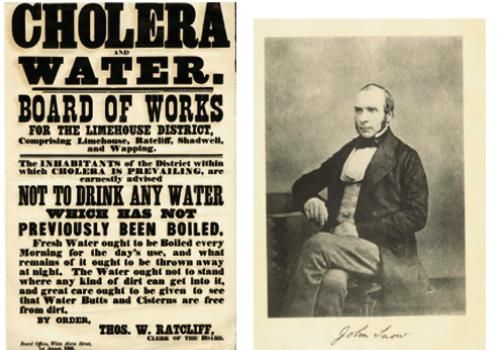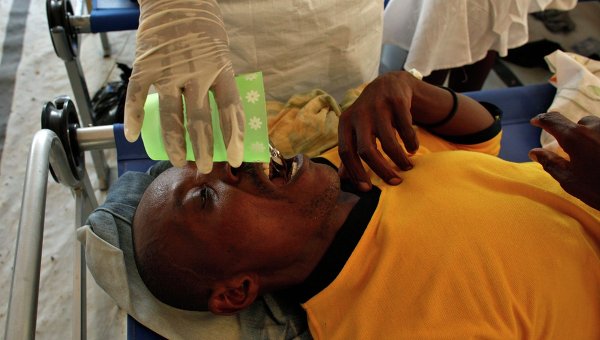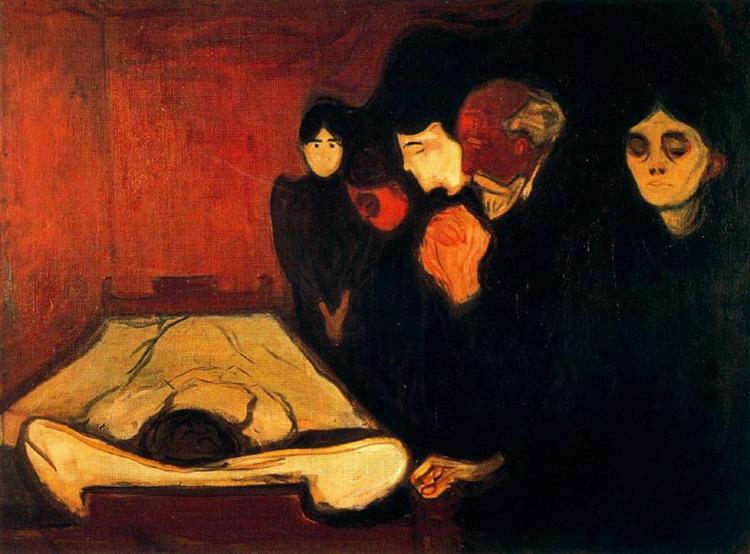The history of world epidemics, part 2
In the first part of the History of World Epidemics, we talked about plague and smallpox. Today we will remember the horrors that cholera “gave us” - its outbreaks were observed 7 times in less than 200 years, and typhus - only during the First World War in Russia and Poland, 3.5 million people died from it.

1866 illustration. A source
Cholera is caused by motile bacteria - cholera vibrio, Vibrio cholerae. Vibrioes breed in plankton in salty and fresh water. The mechanism of cholera infection is fecal-oral. The pathogen is removed from the body with feces, urine or vomiting, and enters the new body through the mouth - with dirty water or through unwashed hands. Mixing wastewater with drinking water and the absence of disinfection leads to epidemics.
The bacteria secrete exotoxin, which in the human body leads to the release of ions and water from the intestine, which leads to diarrhea and dehydration. Some species of bacteria cause cholera, others - cholera-like dysentery.
')
The disease leads to hypovolemic shock - a condition caused by a rapid decrease in blood volume due to water loss, and death.
Cholera is known to mankind since the time of the "father of medicine" of Hippocrates, who died between 377 and 356 BC. He described the disease long before the first pandemic, which began in 1816. All pandemics spread from the valley of the Ganges. The spread was promoted by heat, water pollution and mass accumulation of people at the rivers.
The causative agent of cholera was isolated by Robert Koch in 1883. The founder of microbiology during the outbreaks of cholera in Egypt and India from the feces of patients and the intestinal contents of the corpses of the dead, as well as from water, grew microbes on gelatin-coated glass plates. He managed to isolate the microbes, which had the appearance of curved sticks, resembling a comma. Vibrioes were called "Koch's Comma".

Scientists identify seven cholera pandemics:
The possible cause of the first cholera epidemic was abnormal weather, causing a cholera vibrio mutation. In April 1815, there was an eruption of the volcano Tambor in the territory of present-day Indonesia, a catastrophe of 7 points claimed the lives of ten thousand inhabitants of the island. Then killed up to 50,000 people from the effects, including hunger.
One of the consequences of the eruption was the "year without summer." In March 1816 there was winter in Europe, in April and May there was a lot of rain and hail, in June and July there were frosts in America. Germany was tormented by storms, in Switzerland snow fell every month. The mutation of Vibrio cholerae, possibly together with famine due to cold weather, contributed to the spread of cholera in 1817 in all countries of Asia. From the Ganges, the disease reached Astrakhan. In Bangkok, 30,000 people died.
Stop the pandemic could the same factor that served as its beginning: the anomalous cold of 1823-1824. In total, the first pandemic lasted eight years, from 1816 to 1824.
Calm was short lived. Just five years later, in 1829, a second pandemic broke out on the banks of the Ganges. It lasted for 20 years - until 1851. Colonial trade, improved transport infrastructure, army movements helped the disease spread throughout the world. Cholera has reached Europe, the USA and Japan. And, of course, she came to Russia. The peak in our country came in 1830-1831 years. Cholera riots swept across Russia. Peasants, workers and soldiers refused to tolerate quarantine and high prices for food, and therefore killed officers, merchants and doctors.
In Russia, during the second cholera epidemic, 466,457 people fell ill, of whom 197,069 died. The spread was facilitated by the return of the Russian army from Asia after the wars with the Persians and the Turks.

Emperor Nicholas I with his presence pacifies cholera revolt in St. Petersburg in 1831. Lithograph from the French periodical Album Cosmopolite. Dated 1839 year. A source
The third pandemic belongs to the period from 1852 to 1860. This time, in Russia alone, more than a million people died.
In 1854, 616 people died from cholera in London. There were a lot of problems with sewage and water supply in this city, and the epidemic caused them to start thinking. Until the end of the XVI century, Londoners took water from wells and the Thames, as well as for money from special tanks. Then, for two hundred years, pumps were installed along the Thames, which began to pump water into several areas of the city. But in 1815, the same Thames was allowed to drain the sewers. People washed, drank, cooked food on the water, which was then filled with their own waste products - for seven years. The drain pits, which at that time in London were about 200 thousand, were not cleaned, which led to the Great Stench of 1858.
London doctor John Snow in 1854 found that the disease is transmitted through polluted water. The society has not paid much attention to this news. Snow had to prove his point of view to the authorities. First, he persuaded to remove the handle of the water intake column on Broad Street, where there was an epidemic. He then made a map of cases of cholera, which showed a connection between the sites of the disease and its sources. The greatest number of deaths was recorded in the vicinity of this particular water intake column. There was one exception: no one died in the monastery. The answer was simple - the monks drank exclusively their own beer. Five years later, a new sewer system scheme was adopted.

Announcement in London, distributed in 1854, ordered to use only boiled water
The seventh and last pandemic for cholera today began in 1961 . It was caused by cholera vibrio, more persistent in the environment, called El Tor, after the name of the quarantine station, at which the mutated vibrio discovered in 1905.
By 1970, cholera El Tor swept 39 countries. By 1975, it was observed in 30 countries. At the moment, the danger of the importation of cholera from some countries is not gone.
The highest rate of spread of the infection is shown by the fact that in 1977 an outbreak of cholera in the Middle East in just one month spread to eleven neighboring countries, including Syria, Jordan, Lebanon and Iran.

Magazine cover of the beginning of the 20th century
In 2016, cholera is not as terrible as a hundred and two hundred years ago. Plenty of water is available to much more people; sewage is rarely discharged to the same water bodies from which people drink. The wastewater treatment plant and water supply are on a completely different level, with several degrees of purification.
Although in some countries outbreaks of cholera still occur. One of the most recent cases of cholera epidemic began (and continues) in Haiti in 2010. In total, more than 800,000 people were infected. Up to 200 people fell ill during peak periods. 9.8 million people live in the country, that is, cholera affected almost 10% of the population. It is believed that the beginning of the epidemic laid the Nepalese peacekeepers , who brought cholera to one of the main rivers of the country.
On November 8, 2016, mass vaccination was announced in the country. Within a few weeks, 800,000 people are planned to be vaccinated.

Cholera in Haiti. Photo: RIA News
In October 2016, it was reported that in Aden, the second largest city in Yemen, two hundred cases of cholera were recorded, nine of whom died. The disease has spread through drinking water. The problem is exacerbated by hunger and war. According to the latest data , in all of Yemen, cholera is suspected in 4,116 people.
Under the name "typhus", which translated from ancient Greek means "clouding of consciousness", several infectious diseases are hidden at once. They have one common denominator - they are accompanied by mental disorders in the background of fever and intoxication. Typhoid fever was isolated in a separate disease in 1829, recurrent - in 1843. Before that, all such diseases had one name.
 The group of infectious diseases under the general name "typhus" is caused by rickettsia bacteria - intracellular parasites, named after Howard Taylor Ricketts (pictured), who described the causative agent of Rocky Mountains pathogen in 1909.
The group of infectious diseases under the general name "typhus" is caused by rickettsia bacteria - intracellular parasites, named after Howard Taylor Ricketts (pictured), who described the causative agent of Rocky Mountains pathogen in 1909.
In the USA, this fever is widespread and now, up to 650 cases of the disease are registered annually. On the spread says the fact that in the period from 1981 to 1996, fever occurred in every state of the United States, except Hawaii, Vermont, Maine and Alaska. Even today, when medicine is at a much higher level, the mortality rate is 5-8%. Before the invention of antibiotics, the number of deaths reached 30%.
In 1908, Nikolai Fedorovich Gamaleya proved that the bacteria that cause typhus are transmitted by lice. Most often - wardrobe, which is confirmed by outbreaks in the cold season, periods of "lingering". Gamaley substantiated the importance of disinsection in order to combat typhoid.
Bacteria enter the body through scratches or other skin damage.
After a louse has bitten a person, the disease may not occur. But as soon as a person begins to itch, he rubs the secretions of the intestines with lice, which contain rickettsia. After 10-14 days, after the incubation period, begins chills, fever, headache. After a few days, a pink rash appears. Patients observed disorientation, speech disorders, temperatures up to 40 ° C. Mortality during an epidemic can be up to 50%.
In 1942, Alexey Vasilievich Pshenichnov, a Soviet scientist in the field of microbiology and epidemiology, made a great contribution to the methodology for the prevention and treatment of typhus and developed a vaccine against it. The difficulty in creating a vaccine was that rickettsia cannot be cultivated by conventional methods - bacteria need living cells of an animal or a human. Soviet scientist has developed an original method of infection of blood-sucking insects. Due to the rapid launch in several institutes of production of this vaccine during the Great Patriotic War, the USSR managed to avoid an epidemic.
The time of the first typhus epidemic was determined in 2006, when they examined the remains of people found in a mass grave under the Acropolis of Athens. “Plague of Thucydides” in one year in 430 BC, the disease killed more than a third of the population of Athens. Modern molecular genetic methods have allowed to detect the DNA of the causative agent of typhus.
Typhoid sometimes hit the army more effectively than a live opponent. The second major epidemic of this disease dates back to the years 1505-1530. The Italian doctor Fracastor watched her in the French army besieging Naples. Then noted the high mortality and morbidity of up to 50%.
In the Patriotic War of 1812, Napoleon lost a third of his troops from typhus. Kutuzov's army lost up to 50% of the soldiers from this disease. The next epidemic in Russia was in 1917-1921, this time about three million people died.
Now for the treatment of typhus use antibiotics tetracycline group and chloramphenicol. For the prevention of the disease , two vaccines are used : the Vi polysaccharide vaccine and the Tu21 vaccine developed in the 1970s.
Typhoid fever is characterized by fever, intoxication, skin rashes and damage to the lymphatic system of the lower part of the small intestine. It is caused by Salmonella typhi. Bacteria are transmitted by the alimentary, or fecal-oral, method. In 2000, 21.6 million people suffered from typhoid fever worldwide. Mortality was 1%. One of the most effective ways to prevent typhoid fever is by washing hands and dishes. As well as careful attention to drinking water.
Patients have a rash - roseola, brachicardia and hypotension, constipation, an increase in the volume of the liver and spleen and, which is typical for all types of typhoid, lethargy, delusions and hallucinations. Patients are hospitalized, give Levomycetinum and Biseptol. In the most severe cases, ampicillin and gentamicin are used. At the same time, it is necessary to drink plenty of liquids, it is possible to add glucose-saline solutions. All patients take leukocyte stimulants and angioprotectors.
After a tick or louse bite, a carrier of a bacterium, a person begins the first attack, which is characterized by chills, followed by fever and headache with nausea. The patient has a fever, the skin dries up, the pulse quickens. Enlarged liver and spleen, may develop jaundice. Also noted signs of heart disease, bronchitis and pneumonia.
From two to six days continues the attack, which is repeated after 4-8 days. If the disease after a bite lice is characterized by one or two attacks, then tick-borne typhus causes four or more attacks, although they are easier for clinical manifestations. Complications after the disease - myocarditis, eye damage, spleen abscesses, heart attacks, pneumonia, temporary paralysis.
Antibiotics - penicillin, chloramphenicol, chlortetracycline, and arsenic preparations - novarsenol - are used for treatment.
Fatal cases of relapsing fever are rare, except in Central Africa. Like other types of typhoid, the disease depends on socio-economic factors - in particular, on nutrition. Epidemics among groups of the population that are not available qualified medical care, can lead to mortality of up to 80%.
During World War I, 100,000 people died from relapsing fever, 10% of the country's population.

Edvard Munch "At the deathbed (Fever)". 1893
Humanity managed to drive the plague and smallpox into a test tube due to the high level of modern medicine, but even these diseases sometimes break through to people. And the threat of cholera and typhus exists even in developed countries, what can we say about the developing countries, in which another epidemic may flare up at any moment.
On November 4, 2016, it was reported that an epidemic of typhoid fever threatened Dagestan. About 500 people were hospitalized in Makhachkala with an acute intestinal infection after water poisoning. Two people were in intensive care. To prevent an epidemic, the Ministry of Health of Russia planned to transfer drugs to Algavak M, Vianvak, Shigellvak and Intesty bacteriophage.
The cause of infection in Makhachkala was tap water. The director of the local water utility was arrested, twenty-three more people are under investigation. Now residents of Rostov fear the same.


1866 illustration. A source
Cholera
Cholera is caused by motile bacteria - cholera vibrio, Vibrio cholerae. Vibrioes breed in plankton in salty and fresh water. The mechanism of cholera infection is fecal-oral. The pathogen is removed from the body with feces, urine or vomiting, and enters the new body through the mouth - with dirty water or through unwashed hands. Mixing wastewater with drinking water and the absence of disinfection leads to epidemics.
The bacteria secrete exotoxin, which in the human body leads to the release of ions and water from the intestine, which leads to diarrhea and dehydration. Some species of bacteria cause cholera, others - cholera-like dysentery.
')
The disease leads to hypovolemic shock - a condition caused by a rapid decrease in blood volume due to water loss, and death.
Cholera is known to mankind since the time of the "father of medicine" of Hippocrates, who died between 377 and 356 BC. He described the disease long before the first pandemic, which began in 1816. All pandemics spread from the valley of the Ganges. The spread was promoted by heat, water pollution and mass accumulation of people at the rivers.
The causative agent of cholera was isolated by Robert Koch in 1883. The founder of microbiology during the outbreaks of cholera in Egypt and India from the feces of patients and the intestinal contents of the corpses of the dead, as well as from water, grew microbes on gelatin-coated glass plates. He managed to isolate the microbes, which had the appearance of curved sticks, resembling a comma. Vibrioes were called "Koch's Comma".

Scientists identify seven cholera pandemics:
- The first pandemic, 1816-1824.
- The second pandemic, 1829-1851.
- The third pandemic, 1852-1860.
- The fourth pandemic, 1863-1875
- The Fifth Pandemic, 1881-1896
- The sixth pandemic, 1899-1923
- The seventh pandemic, 1961-1975.
The possible cause of the first cholera epidemic was abnormal weather, causing a cholera vibrio mutation. In April 1815, there was an eruption of the volcano Tambor in the territory of present-day Indonesia, a catastrophe of 7 points claimed the lives of ten thousand inhabitants of the island. Then killed up to 50,000 people from the effects, including hunger.
One of the consequences of the eruption was the "year without summer." In March 1816 there was winter in Europe, in April and May there was a lot of rain and hail, in June and July there were frosts in America. Germany was tormented by storms, in Switzerland snow fell every month. The mutation of Vibrio cholerae, possibly together with famine due to cold weather, contributed to the spread of cholera in 1817 in all countries of Asia. From the Ganges, the disease reached Astrakhan. In Bangkok, 30,000 people died.
Stop the pandemic could the same factor that served as its beginning: the anomalous cold of 1823-1824. In total, the first pandemic lasted eight years, from 1816 to 1824.
Calm was short lived. Just five years later, in 1829, a second pandemic broke out on the banks of the Ganges. It lasted for 20 years - until 1851. Colonial trade, improved transport infrastructure, army movements helped the disease spread throughout the world. Cholera has reached Europe, the USA and Japan. And, of course, she came to Russia. The peak in our country came in 1830-1831 years. Cholera riots swept across Russia. Peasants, workers and soldiers refused to tolerate quarantine and high prices for food, and therefore killed officers, merchants and doctors.
In Russia, during the second cholera epidemic, 466,457 people fell ill, of whom 197,069 died. The spread was facilitated by the return of the Russian army from Asia after the wars with the Persians and the Turks.

Emperor Nicholas I with his presence pacifies cholera revolt in St. Petersburg in 1831. Lithograph from the French periodical Album Cosmopolite. Dated 1839 year. A source
The third pandemic belongs to the period from 1852 to 1860. This time, in Russia alone, more than a million people died.
In 1854, 616 people died from cholera in London. There were a lot of problems with sewage and water supply in this city, and the epidemic caused them to start thinking. Until the end of the XVI century, Londoners took water from wells and the Thames, as well as for money from special tanks. Then, for two hundred years, pumps were installed along the Thames, which began to pump water into several areas of the city. But in 1815, the same Thames was allowed to drain the sewers. People washed, drank, cooked food on the water, which was then filled with their own waste products - for seven years. The drain pits, which at that time in London were about 200 thousand, were not cleaned, which led to the Great Stench of 1858.
London doctor John Snow in 1854 found that the disease is transmitted through polluted water. The society has not paid much attention to this news. Snow had to prove his point of view to the authorities. First, he persuaded to remove the handle of the water intake column on Broad Street, where there was an epidemic. He then made a map of cases of cholera, which showed a connection between the sites of the disease and its sources. The greatest number of deaths was recorded in the vicinity of this particular water intake column. There was one exception: no one died in the monastery. The answer was simple - the monks drank exclusively their own beer. Five years later, a new sewer system scheme was adopted.

Announcement in London, distributed in 1854, ordered to use only boiled water
The seventh and last pandemic for cholera today began in 1961 . It was caused by cholera vibrio, more persistent in the environment, called El Tor, after the name of the quarantine station, at which the mutated vibrio discovered in 1905.
By 1970, cholera El Tor swept 39 countries. By 1975, it was observed in 30 countries. At the moment, the danger of the importation of cholera from some countries is not gone.
The highest rate of spread of the infection is shown by the fact that in 1977 an outbreak of cholera in the Middle East in just one month spread to eleven neighboring countries, including Syria, Jordan, Lebanon and Iran.

Magazine cover of the beginning of the 20th century
In 2016, cholera is not as terrible as a hundred and two hundred years ago. Plenty of water is available to much more people; sewage is rarely discharged to the same water bodies from which people drink. The wastewater treatment plant and water supply are on a completely different level, with several degrees of purification.
Although in some countries outbreaks of cholera still occur. One of the most recent cases of cholera epidemic began (and continues) in Haiti in 2010. In total, more than 800,000 people were infected. Up to 200 people fell ill during peak periods. 9.8 million people live in the country, that is, cholera affected almost 10% of the population. It is believed that the beginning of the epidemic laid the Nepalese peacekeepers , who brought cholera to one of the main rivers of the country.
On November 8, 2016, mass vaccination was announced in the country. Within a few weeks, 800,000 people are planned to be vaccinated.

Cholera in Haiti. Photo: RIA News
In October 2016, it was reported that in Aden, the second largest city in Yemen, two hundred cases of cholera were recorded, nine of whom died. The disease has spread through drinking water. The problem is exacerbated by hunger and war. According to the latest data , in all of Yemen, cholera is suspected in 4,116 people.
Typhus
Under the name "typhus", which translated from ancient Greek means "clouding of consciousness", several infectious diseases are hidden at once. They have one common denominator - they are accompanied by mental disorders in the background of fever and intoxication. Typhoid fever was isolated in a separate disease in 1829, recurrent - in 1843. Before that, all such diseases had one name.
Typhus
 The group of infectious diseases under the general name "typhus" is caused by rickettsia bacteria - intracellular parasites, named after Howard Taylor Ricketts (pictured), who described the causative agent of Rocky Mountains pathogen in 1909.
The group of infectious diseases under the general name "typhus" is caused by rickettsia bacteria - intracellular parasites, named after Howard Taylor Ricketts (pictured), who described the causative agent of Rocky Mountains pathogen in 1909.In the USA, this fever is widespread and now, up to 650 cases of the disease are registered annually. On the spread says the fact that in the period from 1981 to 1996, fever occurred in every state of the United States, except Hawaii, Vermont, Maine and Alaska. Even today, when medicine is at a much higher level, the mortality rate is 5-8%. Before the invention of antibiotics, the number of deaths reached 30%.
In 1908, Nikolai Fedorovich Gamaleya proved that the bacteria that cause typhus are transmitted by lice. Most often - wardrobe, which is confirmed by outbreaks in the cold season, periods of "lingering". Gamaley substantiated the importance of disinsection in order to combat typhoid.
Bacteria enter the body through scratches or other skin damage.
After a louse has bitten a person, the disease may not occur. But as soon as a person begins to itch, he rubs the secretions of the intestines with lice, which contain rickettsia. After 10-14 days, after the incubation period, begins chills, fever, headache. After a few days, a pink rash appears. Patients observed disorientation, speech disorders, temperatures up to 40 ° C. Mortality during an epidemic can be up to 50%.
In 1942, Alexey Vasilievich Pshenichnov, a Soviet scientist in the field of microbiology and epidemiology, made a great contribution to the methodology for the prevention and treatment of typhus and developed a vaccine against it. The difficulty in creating a vaccine was that rickettsia cannot be cultivated by conventional methods - bacteria need living cells of an animal or a human. Soviet scientist has developed an original method of infection of blood-sucking insects. Due to the rapid launch in several institutes of production of this vaccine during the Great Patriotic War, the USSR managed to avoid an epidemic.
The time of the first typhus epidemic was determined in 2006, when they examined the remains of people found in a mass grave under the Acropolis of Athens. “Plague of Thucydides” in one year in 430 BC, the disease killed more than a third of the population of Athens. Modern molecular genetic methods have allowed to detect the DNA of the causative agent of typhus.
Typhoid sometimes hit the army more effectively than a live opponent. The second major epidemic of this disease dates back to the years 1505-1530. The Italian doctor Fracastor watched her in the French army besieging Naples. Then noted the high mortality and morbidity of up to 50%.
In the Patriotic War of 1812, Napoleon lost a third of his troops from typhus. Kutuzov's army lost up to 50% of the soldiers from this disease. The next epidemic in Russia was in 1917-1921, this time about three million people died.
Now for the treatment of typhus use antibiotics tetracycline group and chloramphenicol. For the prevention of the disease , two vaccines are used : the Vi polysaccharide vaccine and the Tu21 vaccine developed in the 1970s.
Typhoid fever
Typhoid fever is characterized by fever, intoxication, skin rashes and damage to the lymphatic system of the lower part of the small intestine. It is caused by Salmonella typhi. Bacteria are transmitted by the alimentary, or fecal-oral, method. In 2000, 21.6 million people suffered from typhoid fever worldwide. Mortality was 1%. One of the most effective ways to prevent typhoid fever is by washing hands and dishes. As well as careful attention to drinking water.
Patients have a rash - roseola, brachicardia and hypotension, constipation, an increase in the volume of the liver and spleen and, which is typical for all types of typhoid, lethargy, delusions and hallucinations. Patients are hospitalized, give Levomycetinum and Biseptol. In the most severe cases, ampicillin and gentamicin are used. At the same time, it is necessary to drink plenty of liquids, it is possible to add glucose-saline solutions. All patients take leukocyte stimulants and angioprotectors.
Relapsing fever
After a tick or louse bite, a carrier of a bacterium, a person begins the first attack, which is characterized by chills, followed by fever and headache with nausea. The patient has a fever, the skin dries up, the pulse quickens. Enlarged liver and spleen, may develop jaundice. Also noted signs of heart disease, bronchitis and pneumonia.
From two to six days continues the attack, which is repeated after 4-8 days. If the disease after a bite lice is characterized by one or two attacks, then tick-borne typhus causes four or more attacks, although they are easier for clinical manifestations. Complications after the disease - myocarditis, eye damage, spleen abscesses, heart attacks, pneumonia, temporary paralysis.
Antibiotics - penicillin, chloramphenicol, chlortetracycline, and arsenic preparations - novarsenol - are used for treatment.
Fatal cases of relapsing fever are rare, except in Central Africa. Like other types of typhoid, the disease depends on socio-economic factors - in particular, on nutrition. Epidemics among groups of the population that are not available qualified medical care, can lead to mortality of up to 80%.
During World War I, 100,000 people died from relapsing fever, 10% of the country's population.

Edvard Munch "At the deathbed (Fever)". 1893
Humanity managed to drive the plague and smallpox into a test tube due to the high level of modern medicine, but even these diseases sometimes break through to people. And the threat of cholera and typhus exists even in developed countries, what can we say about the developing countries, in which another epidemic may flare up at any moment.
On November 4, 2016, it was reported that an epidemic of typhoid fever threatened Dagestan. About 500 people were hospitalized in Makhachkala with an acute intestinal infection after water poisoning. Two people were in intensive care. To prevent an epidemic, the Ministry of Health of Russia planned to transfer drugs to Algavak M, Vianvak, Shigellvak and Intesty bacteriophage.
The cause of infection in Makhachkala was tap water. The director of the local water utility was arrested, twenty-three more people are under investigation. Now residents of Rostov fear the same.

Source: https://habr.com/ru/post/399379/
All Articles